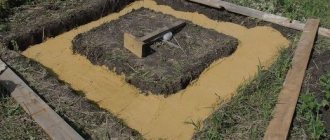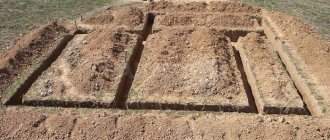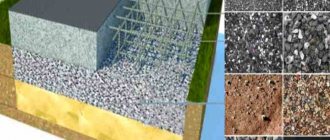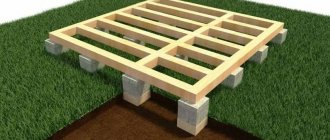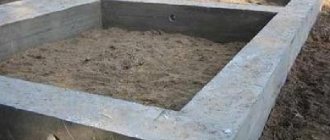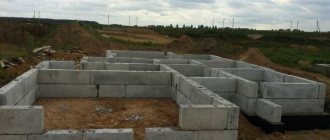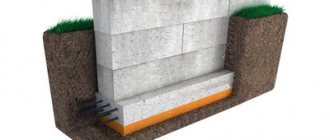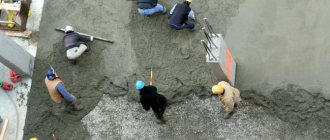How to properly make a pillow for a strip foundation: structure and dimensions, stages of work.
Scheme of pouring a monolithic foundation. The main parameters of the strip foundation technology are:
- Depth . This value depends on the weight of the building, as well as on the freezing of the soil in the area.
- Width . Depends on the material and width of the walls and should be at least equal to . but it is better if it exceeds the width of the walls by 10-15 cm .
After calculating the size of the required foundation, you should decide on the size of the cushion under it. The base performs several functions :
- Levels the surface . on which the foundation will be laid. This is more important if concrete blocks are used. There are no voids left under them and they rest on the ground their entire surface. In case of pouring a strip foundation. alignment less .
- Ensures uniform distribution of soil loads from the foundation.
- There is another important function that the pillow performs: it combats moisture in the soil and its impact on the entire structure due to seasonal temperature changes.
Note! If you remove heaving soil and replace it with non-heaving soil . this will significantly reduce the impact on the foundation when water freezes in winter.
Simple deformation of the base.
The soil will put pressure on the side walls of the foundation, pushing it upward, and the values of the buoyancy force can reach 5 - 7 tons per 1 m² of the base of the house. This is especially dangerous for timber or frame buildings that have little dead weight. Stone buildings, due to their mass, can compensate for lateral forces acting on the foundation.
protect yourself from heaving by placing a cushion under the foundation, replacing heaving soil with non-heaving soil. The same applies to backfill - the use of non-expanding soil will reduce the effect of tangential loads.
Pillow design and dimensions.
The average thickness of a sand cushion is considered to be 60 cm . It can vary in one direction or another depending on the type of soil. Severely heaving soils may require increasing this value to 80 centimeters or more. You can often find a recommendation that the thickness of the cushion should be 3 times the width of the foundation.
Foundation pillows.
The width of the pillow should protrude beyond the dimensions of the foundation by 15 - 20 cm in each direction. In the event that a basement is planned. then the sand cushion should be arranged not only under the foundation, but also under the entire area of the house.
The concrete floor of the basement is subject to the same loads, which means it also needs to be protected from the effects of the soil due to temperature fluctuations.
In the event that the soil is very heaving . A sand-crushed stone cushion is used, in which sand occupies 40% of the volume.
For laying, it is necessary to use pre-moistened sand, which will improve compaction . You can moisten it after laying sand in the trench, but do this only if the soil is not prone to erosion.
Important! It is advisable to use geotextiles to prevent sand from silting and mixing with the soil.
The sand is laid in layers of 15-20 cm with mandatory compaction, for which rollers or area vibrators are used. As a last resort, you can use an ordinary log with a handle, but then the thickness of the layer will have to be reduced to 10 cm or less. Tamping is carried out to a density of 1.6 t/m³ . It's easy . If, after walking on the compacted sand, no traces remain , then you can begin filling the next layer.
When using a sand-crushed stone mixture for wooden buildings or prefabricated frame structures, compaction can be neglected . If a building is being erected from brick or similar material, then compaction must be carried out, but the thickness can be increased by several layers.
What material to choose for a pillow?
Sand cushion for the foundation.
For use as a pillow under the foundation, different materials are used:
- Sand . The best option is to use medium or coarse gravelly It should not contain dust or clay impurities. For example, river sand .
- Crushed stone . The optimal fraction size is 20-40 mm .
Let us repeat that the presence of clay fractions in the sand or the use of clay to create a cushion is unacceptable .
Attention! On soft soils, with close proximity to soil water, useful to install an additional drainage system.
Types and arrangement of pillows under the foundation.
- Construction of a foundation cushion Cushion for a strip foundation made of sand
- Crushed stone pillow
- Concrete foundation cushion
Forming the foundation is one of the important processes when building a house. Compliance with all the requirements when laying it will enable the building to serve for a long time without causing various kinds of problems to its owner.
Foundation pad for strip foundation.
Construction of a foundation on a sand bed.
The foundation cushion is of great importance when building the foundation. Thanks to its proper organization:
- The load is distributed evenly along the entire perimeter of the base.
- Use it to level the bottom for the bookmark.
- Drainage is carried out (melt and rainwater are removed).
- Freezing of the lower section of the structure does not occur.
Why do you need a pillow under the foundation?
The cushion gives stability to the foundation. Its device helps solve the following issues:
- replace heaving soils from under the supporting structure with the calmest fillers. Soil with admixtures of clay or peat during seasonal temperature changes can create level fluctuations reaching ten centimeters. Such manifestations affect the integrity of the foundation and walls of the building. Recession should be carried out below the freezing point;
- the cushion redistributes the load effects due to surface contact with the lower supporting plane. Any unevenness, especially on rocky soil, is covered with fine-grained material, which is subsequently compacted and creates a smooth surface;
- prevents the capillary rise of moisture to the concrete of the foundation strip.
At each of these points, the thickness of the cushion under the strip foundation may be different.
Sometimes the condition of the site allocated for development makes it possible to do without a sand cushion. In this case, the concrete mass fills the entire cavity, compensating for uneven areas. Polymer components are added to the mortar mass as an addition, increasing resistance to moisture.
In cases where the foundation is made of reinforced concrete blocks, a cushion for the strip foundation is required to give the stones stability and evenly distribute the load effects.
Installation of a foundation cushion.
Before starting construction, trenches for a strip base or a foundation pit for a monolithic one are dug in a cleared and marked area. All loose soil is removed and the bottom of the trench is leveled. Then a layer of crushed stone is formed under the foundation. sand, gravel or concrete.
Cushion for a strip foundation made of sand.
Scheme of the sand cushion structure.
Diagram of the installation of a sand cushion under a strip foundation.
To create a layer of sand under the base you will need:
- Sand with coarse or medium grain without various inclusions (especially clayey ones).
- Geotextiles or roofing felt will serve as a barrier against groundwater.
- Level, pegs and rope.
- Vibrating plate or homemade rammer.
Before installing the layer, all loose soil is removed from the bottom of the trench. Geotextiles or roofing felt are laid on its bottom with an overlap (10 cm). These materials will prevent sand from mixing with the soil. Also, when backfilling, an important point is to respect the horizon line. To do this, use pegs and rope to set the desired level.
Sand is poured on top of the laid material.
Backfilling is carried out in small portions and moistened with water.
Each layer is then compacted using a vibrating plate. Tamping is carried out until no traces remain on the surface. Each layer should be approximately 10 cm high.
Forming a foundation cushion. Usually its height is normal 20-30 cm. To calculate the maximum permissible height, you need to triple the width of the tape. The created layer should resemble a trapezoid in its cross-section. Its narrowest part should be located at the bottom (a tilt angle of 30 degrees is desirable).
The organization of this layer option for a strip foundation is relevant:
- If leveling of the bottom of a trench or pit is required.
- If you need to replace soil with strong heaving with sand.
Crushed stone pillow.
To install a crushed stone cushion under a strip foundation, the following material is required:
Pillow under the foundation section.
Construction of a rubble concrete foundation.
- River sand with coarse grains.
- Crushed stone or gravel 20-40 mm in size.
The formation of a crushed stone base begins with a layer of sand. Its thickness is 10-15 cm. The resulting layer must be wetted and the compaction process is carried out using the same devices as in the previous version.
Crushed stone about 20 cm thick is poured onto the compacted layer. In total, the height of crushed stone and sand should be 30-40 cm. The crushed stone is compacted. As a result, the crushed stone must lie strictly in a horizontal plane. The width of the interlayer is equal to the width of the planned base tape with the addition of 15-20 cm on one and the other side.
This simple version of the base for a strip foundation will withstand the load from a structure of several floors.
The foundation pad is concrete.
This version of the device is more expensive, but also justified. If formed correctly, the foundation with a concrete pad will become a solid foundation for the future structure. To build it you will need:
- Concrete.
- Crushed stone or gravel.
- Boards.
- Vibrating plate or homemade rammer.
- Metal rods.
To begin with, crushed stone 10 cm high is placed at the bottom of a leveled trench under a strip foundation. It is compacted using a homemade device or a vibrating plate. Then formwork from boards is mounted on the crushed stone base. Its height should be equal to the height of the future pillow (up to 30 cm). The width of the layer is the width of the foundation plus 15 cm on both sides.
To increase strength, the pillow is reinforced (strengthened) using metal rods with a diameter of 8-12 mm. A frame is created from the reinforcement material by welding or tying structural elements together.
Concrete is poured into the formwork with a metal frame. The brand of this material will depend on the weight of the future structure. After the pouring process, the concrete is compacted using a deep vibrator. Rods 40-60 cm long are inserted into the prepared base for further coupling of the concrete base with the foundation. They should protrude half their length above the surface.
When forming a concrete preparation for the construction of a lighter structure, crushed stone can be replaced with sand. Form a layer of 10 cm and water it with water to compact it. The following manipulations are identical to the above-described version of the device.
For a strip foundation, a concrete pad will become a solid foundation with a fairly long service life. If properly organized, it will withstand the significant weight of the structure and serve as an excellent foundation.
Every type of pillow has a right to exist. Despite the fact that the formation of a base for the foundation can be done from different materials, if the process is carried out correctly, any of the above options will be a reliable support for the future structure.
Features of a sand cushion under the foundation
A sand cushion under the foundation allows you to correct soil imperfections. Therefore, it is always recommended to do it, regardless of the type of foundation chosen. This ensures the long life of the house. Therefore, more attention should be paid to the choice of sand and adherence to technology.
Why do you need a sand pillow?
It is important to find out why you need a sand cushion under the foundation before building a house. This is a very useful element that:
- Helps correct unevenness in pits and trenches. This allows you to save concrete solution.
- Reduces soil load.
- Allows you to avoid soil mobility during spring floods.
- Improves the strength of subsiding and unstable soil.
- Used to replace heaving soil to increase bearing capacity. This will make the foundation strong, holistic, and increases its durability.
- Facilitates the process of building a house in the swamps.
- It prevents melt water from soaking the base of the building and also protects against the penetration of groundwater.
- Makes the foundation resistant to high temperatures.
- Provides stabilization of the structure and does not allow it to settle.
Considering these functions, it becomes clear why it is needed.
Which sand is better
The type of sand you need depends on the area. Experts recommend using gravelly sand. It will provide compaction and the structure will not shrink after some time.
But some builders prefer a layer of sand and crushed stone, since this mixture prevents flooding and levels the surface.
Sand or crushed stone are popular materials, but sand and gravel cushions for foundations are no less often used.
Device depending on the foundation
All builders know why a sand cushion under the foundation is needed. But not every specialist is convinced of its effectiveness. There is an opinion that it is not suitable for certain options.
Tape
Strip foundations are used with a thin sand cushion only for small buildings.
The calculation of the sand cushion must be carried out so that its width is several tens of centimeters greater than the width of the tape.
To level the ground and avoid liquid penetration into the foundation, as well as for other purposes, all actions must be performed in the correct sequence:
- Place a layer of sand that is necessary for a given type of soil and distribute it evenly over the area.
- Moderately moisten the sand with water so that it settles more tightly and is easier to compact.
- In order to get a dense pillow without voids, and the house does not sag, they resort to special construction equipment for compaction.
- Any unevenness on the cushion is eliminated so that this does not have to be done later during the construction of the foundation.
- Treat the working surface with a waterproofing layer.
It is important to check the thoroughness of compaction. If there are no marks on it, then the work was done correctly.
A sand cushion under the foundation is not needed if a monolithic base is used. This is possible provided the soil is not heaving. Also, a foundation cushion without sand is allowed if you plan to build a house on sandy soil.
It is impossible to create a base from FBS without a sand cushion. Such a foundation on a sand cushion without deepening requires preliminary leveling of unevenness formed after removing the loosened layer of soil.
If you place a foundation made of blocks directly on the ground, then voids will form under it and the house will gradually sag unevenly.
Columnar
A column foundation is a solid foundation, but it must be supported with sand and gravel. What sand or crushed stone should be found out first to avoid serious mistakes. First, medium-sized solid fractions of gravel are placed under the pile foundation and all this is diluted with sand. To ensure that the components fit together more tightly, they are filled with a small amount of water and tamped down.
The height of the sand cushion is allowed up to 30 cm.
Finally, polyethylene is placed on the surface to prevent water from being absorbed into the pillow.
Slab
A slab foundation on a sand cushion has the same structure as a strip foundation, but is carried out over the entire area of the pit. To create the correct layer, you need to find out how to do it and whether it is needed for this type of base. The procedure is carried out as follows:
- Dig a hole in the ground under the foundation and carefully level its bottom.
- A certain amount of gravel or crushed stone is placed there. How many centimeters to pour is determined by the density of the soil. If it is small, then fifteen centimeters is enough.
- Sand is poured onto the crushed stone. Which is better, river or quarry, is chosen at your own discretion. If you are planning a small cottage, then 10 cm will be enough. This will distribute the load equally over the entire base area.
- Compact using a vibrating plate.
Whether a layer is needed or not, many builders argue. But the majority agrees that it is impossible to do without it.
Before installing the foundation, cover the sand with waterproofing.
Making the pillow right
If the base is of poor quality, then the walls may be cut, the base will be destroyed, and other problems will appear.
Geotextiles must be placed under the base of the foundations. This product reduces the risk of moisture penetrating the base material. Next you need to pour a layer of the selected material.
Before starting work, you need to clean the sand from contaminants by sifting.
When all the material is filled in, close the water-repellent material. At the end, sand is added, but no more than half a centimeter, so that a shallow foundation on a sand cushion does not deteriorate the properties of the protective coating.
Sand cushion on clay is also used in house construction, but sometimes it is better to resort to more durable options. The decision is made depending on the soil on which the building will be built. If the groundwater is near the surface, it is better to create a solid base to avoid problems in the future.
According to SNIP - building codes and regulations, what kind of sand is used and the height of its embankment is determined from calculations and terrain conditions. If they are normal, then:
- For a strip foundation, a fifteen-centimeter embankment is sufficient. After compaction it should be up to 30 cm high.
- A tiled base requires a backfill of 10-15 cm, and a brick base - 25 cm.
- If the foundation is on columns or piles, then a mixture of crushed stone and sand up to 30 cm, and sometimes up to 60 cm, is required.
If the area is swampy or the groundwater is too close to the surface, then you need help from people who understand these issues. They will determine what the sand cushion under the foundation is for in this case and what to make it from. It is not advisable to use a regular layer for such cases. To increase efficiency, it is necessary to continue drainage and drainage.
The purpose for which an intermediate link is installed between the soil and the foundation is to connect the building to the ground.
During pouring, you need to follow a number of recommendations:
- Form slopes with a steepness of 1:1.15.
- Sow grass, make turf and strengthen the soil in other available ways.
- Make a slope of at least three degrees from the center to the outside.
- Geotextiles must be placed under the base of the MIT foundations.
For ordinary sand, any available means is suitable, but if you add gravel, you will need heavier artillery in the form of:
- vibrolegs. To operate it, a motor is installed that runs on diesel fuel. The large heel compacts the material.
- vibrating plates. Suitable for slab-type foundations;
- vibratory roller It is used to compact the sand layer on large construction sites.
This approach to creating a substrate has many advantages:
- no need to spend a lot on materials;
- mail does not suffer from excessive load;
- there is no need to rent expensive construction equipment, since the embankment can be made more dense using affordable means.
Therefore, such foundations are very popular in construction. They ensure the stability of the foundation and protect the house from shrinkage, destruction of the base and other damage that can entail significant financial costs.
Installation of a pillow under a strip foundation.
Foundation cushion for the strip foundation of a cottage.
In order for the strip foundation to serve as a reliable support for the house for as long as possible, you should strictly adhere to all technologies for its manufacture. The installation of a cushion under the foundation helps to increase the shock-absorbing qualities of the foundation and reduce the level of exposure to moisture. Let’s look further at how to properly make a pillow for a strip foundation with your own hands.
Advantages of making a strip foundation for a house.
Strip foundations are most often used in suburban housing construction. In addition, it is also popular in the construction of summer houses, outbuildings or cottages. This foundation can support any house, whether wooden or frame, brick or stone. It is precisely because of the high strength and reliability of the foundation that it is an excellent foundation for massive walls. In addition, this foundation also allows the installation of a basement floor.
Foundation pad for strip foundation dimensions.
A strip foundation is a reinforced concrete form that is laid around the perimeter of the building and in areas of load-bearing walls and partitions. In this way, it is possible to eliminate distortions or deformations of the house. Since a properly equipped foundation allows you to evenly distribute the load from the entire weight of the building.
An obligatory stage in arranging a strip foundation is laying a sand and gravel cushion. It will provide its reliable protection from moisture, and in particular groundwater.
The choice of a strip foundation is associated primarily with the presence of a huge amount of excavation work, which is carried out either manually or using special equipment. In addition, setting up such a foundation will require a lot of physical effort and time, especially to harden it.
In relation to the manufacturing technology of strip foundations, there are three types:
Sand cushion under the foundation section.
The first option is based on installing concrete blocks inside the trench and connecting them together using a mortar based on sand and cement.
The monolithic version, although it requires more time and effort for its construction, is distinguished by higher strength and quality of the connected elements. The solidity of the structure is ensured by pouring the previously installed foundation reinforcement with concrete mortar.
The combined version of the strip foundation is based on a combination of the two previous options. The pile field is assembled along the upper part of the foundation, and its lower part is filled with concrete mortar. Next, the reinforced concrete blocks are installed.
Among the advantages of a strip foundation, we note:
- the cost of construction work, compared to the quality of the foundation, is affordable;
- long service life - a strip foundation can serve its owners for more than a hundred years, the main rule is compliance with the technology of its construction, in addition, this type of foundation can be easily restored and even partially or completely replaced;
- simplicity of work - if desired, all work can be done manually, although this will require a lot of time, you can save a lot;
- the ability to withstand impressive loads is another significant advantage of a strip foundation; such a foundation is suitable for a house made of any materials;
- the possibility of arranging the basement floor under the house allows you to create additional space for storing things or for relaxation.
Foundation pad for strip foundation pouring.
Among the disadvantages of strip foundations, we highlight:
- the complexity of the work, the need for a large amount of time for concrete to harden;
- the need for accurate calculations of the depth of the foundation, the thickness of the pillows, etc.;
- the occurrence of problems with the foundation if the technology for its construction is not followed.
A strip foundation requires very precise calculations before its construction. Its depth and width must be clearly compared with the weight of the building and the type of soil on which it is built.
The minimum value of the foundation heel is 0.3 × 0.8 m. In addition, it is necessary to take into account the quality and features of the ligation of two belts. If the reinforcing belt is too weak, there is a risk of dividing the foundation into several parts.
If the soil in the area on which the foundation is being built is hard, then the trench is expanded only to install the formwork. For soft soil, you should leave a small space, about 12 cm thick, to fill it with sand. With the help of this pillow it is possible to compensate for ground movements during seasonal changes in the terrain.
Foundation cushion for a slab foundation of a house.
Why do you need a sand cushion under the foundation? Device tips
Why do you need a sand cushion under the foundation? Tips for the device The need for a special pillow under the sole of the strip foundation is often discussed (photo 1). Let's try to figure out this issue and get rid of unnecessary doubts - to make or not to make a pillow?
Installing a sand cushion under the foundation - what is it for, how to do it correctly?
A special cushion is made either from soil (soil cushion): sand, sand-crushed stone mixture or crushed stone, or it is made from lean low-grade concrete (concrete preparation).
Sand is used in soil cushions because of its ability to compact very quickly and easily. To compact sand, it is enough to take sand of natural moisture (if the sand is dry, then it should be slightly moistened), lay it on the bottom of the trench (pit) and compact it with a regular hand tamper.
Advice! Let us draw your attention to the fact that you should not overly moisten the sand cushion, as this will not lead to its compaction, but, on the contrary, to its decompression.
What is a sand cushion used for? A sand cushion under the foundation is necessary to level the base, that is, to uniformly transfer pressure from the foundation to the soil base (photos 3 and 4). For example, you definitely cannot do without a soil cushion when constructing a foundation in the form of a monolithic reinforced concrete slab or when installing a prefabricated pool.
It is easier to level the bottom of narrow trenches with sand or a sand-crushed stone mixture. This is done both in the case of installation of prefabricated reinforced concrete foundations, and in preparation for the implementation of monolithic strips. In particular, when laying monolithic strips, the soil cushion provides the same protective layer of concrete (the distance from the reinforcing bars to the level of the base of the foundation). If the cushion is not laid, then you need to very carefully clean and level the soil, cut off the bumps at the bottom of the trench (imagine how inconvenient it is to do this in narrow and deep trenches, next to which the developed soil is poured into dumps). When carrying out excavation work in clayey soils (clay, loam, sandy loam, etc.), the so-called manual soil amendment is practiced. That is, they dig a trench using an excavator, and then work the soil manually to a depth of 10...15 cm, because the bucket loosens the soil at the bottom of the trench (pit). It is difficult to refine the soil in narrow trenches 30...50 cm wide, and this often leads to the collapse of the soil of the trench walls. Therefore, in real low-rise construction, such modification is not practiced, and in order to ensure that the contact of the foundation does not occur on loose soil, it is replaced with sand, which is very easily compacted (unlike clay soils). Sand is often used to replace existing unsuitable soil. This is done in order to save material (in this case concrete). For example, the depth of clay layers is 1.4 m from the ground surface, and it is possible to lay the base of the foundation to a depth of 1.1 m. Since the foundations under the main walls should not be supported on the soil-vegetative layer, it is possible to make a sand cushion under strip foundation 0.3 m thick, which will save heavy concrete. A sand cushion is also installed to save concrete for the foundation for the following reasons. For example, they try to make a foundation on clay soils slightly below the depth of seasonal freezing (10...15 cm). For example, in my region for clay soils this depth is 1.1 m. In order not to bury the base below this level, you can place sand under the base of the foundation, which most likely does not increase in volume when frozen (frost heaving). Thus, the foundation can be made not 1.2...1.25 m deep, but 1.1 m deep.
Soil cushions are not performed in the following conditions: with a high level of groundwater (in flooded areas); in the presence of sandy foundation soils.
Now you know a lot about the sand cushion under the foundation and when it is worth providing for it.

